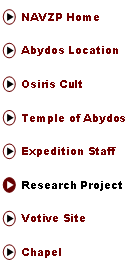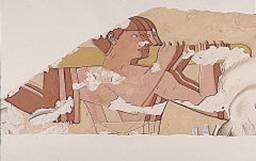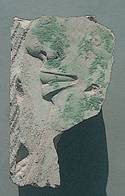




|
Menu |
|
Research Project
In 1996, under the field direction of Dr. Mary-Ann Pouls Wegner, an archaeological research project investigating the Votive Zone was initiated. The ongoing program of research incorporates topographical and archaeological survey as well as selective excavation, and is being carried out under the auspices of the University of Pennsylvania-Yale University-Institute of Fine Arts, New York University Expedition to Abydos (Drs. David O'Connor and William Kelly Simpson, co-directors).
The methodology of the project incorporated a strategy aimed at recovering traces of the full range of ancient ritual activities at the site in order to reconstruct the ancient ceremonial landscape of North Abydos and to understand changes in the utilization of the Votive Zone site over time. The first phase of the project was an intensive topographical survey of the site, which provided important insights into the excavation history of the area. In addition, the survey generated data that allowed for the creation of a detailed contour map of the site, allowing for the understanding of the spatial relationships that existed between elements of the built and natural environment. This data was incorporated into the site-wide system of survey control established by Dr. Wegner in 1999, which accurately linked together all of the features of the Greater Abydos Area into a relational geographical system for the first time.
The second phase of the project utilized the analysis of material collected from the surface of the site to help understand the history and range of activities represented there. The archaeological survey incorporated a comprehensive programme of sampling and analysis that allowed for the identification of changes in the utilization of the Votive Zone over time. On the basis of the results of this analysis of the material culture remains from the surface of the site, areas in which to focus selective excavation were selected.
Subsequent phases of research have involved selective excavation and the recording and analysis of archaeological material recovered through excavation in the Votive Zone. Excavation revealed significant royal investment in the Votive Zone in a period about which very little was previously known: the 18th Dynasty. The discovery of a chapel built by Thutmose III at the site demonstrates that royal building activity took place in the Votive Zone during the 18th Dynasty. Analysis of the relief program and the unusual architectural form of the structure provides insight into its function in the context of the Osiris cult at Abydos. This function is clearly related to developments elsewhere in North Abydos. The identification of the remains of another chapel of Thutmose III on the other side of the wadi, at the edge of the Middle Cemetery, provides evidence of the state's role in the organization of the ritual landscape of North Abydos during the 18th Dynasty. Analysis of the spatial relationships that existed between these structures and other elements of the built and natural environment of Abydos, reconstructable through examination of the traces of roadways connecting these elements and through the identification of patterning in the artefactual material distributed across the area, enables a deeper understanding of the development of the ritual landscape of North Abydos as a whole. |
|
Watercolour copy of a fragment of decorated relief from the Votive Zone chapel of Thutmose III, depicting priests carrying an image of the deity in a barque shrine through the North Abydos landscape. Such processions allowed the populace to interact with the god. The painting is by one of the archaeological illustrators for the project, Tamara Bower. |
|
Much of the analysis of the artefactual material produced in the course of fieldwork at the site, including ceramic remains and small objects as well as relief fragments from the chapel's programme of decoration, has been carried out in Toronto since 2000, through the support of the work-study programme and a Connaught Start-up Grant from the University of Toronto. This research has involved students in the analysis and interpretation of archaeological material, and training the next generation of researchers is an integral part of the project's design. Future research will focus on expanding the understanding of the development of the ritual landscape of North Abydos, and on elucidating the range of votive behaviour represented at the site. The ongoing archaeological investigation of the Votive Zone has great potential to contribute to our understanding of social relationships and ritual practice in ancient Egyptian society. |
|
The presence of intact archaeological deposits associated with the Votive Zone chapel of Thutmose III has allowed for the reconstruction of activities carried out in that context over the long span of its utilization. The microstratigraphic analysis of these deposits has greatly enriched our understanding of aspects of ancient ritual activity that involved individuals from a variety of socio-economic levels, ranging from offerings of incense and libations to the statues that once stood inside the chapel, to the dedication of small votive bowls and other objects in the chapel's sanctuaries, to the care of sacred trees in the chapel's forecourt.
Other evidence of the interaction between royal and private agency in the development of the area have also been recovered from the Votive Zone excavations. Alongside the data relating to state-level construction activity at the site, the excavation seasons of 1996 and 1997 also produced significant evidence of votive activity carried out by individuals from many different socio-economic levels of society. Indications of major shifts in the utilization of the site over time were noted, and spatial patterning of artefactual material was also observed. This data has enabled us to reconstruct the history of use of the site, and has provided a broader perspective on how it functioned in the context of the ancient society represented there. These aspects of the archaeological record form a major focus of ongoing research in the Votive Zone.
The analysis of artefacts associated with votive activity by non-elite members of society which were placed inside and around the structure also allows for a better understanding of the industries present at the site. A wide range of artefact types were utilized by pilgrims and local community members as offerings deposited in the Votive Zone. These aspects of the material culture preserved at the site contribute important new information about the urban development of Abydos as a major ceremonial centre that supported a range of manufacturing industries related to the production of material for votive use. |


|
Limestone fragment bearing carved and painted image of the god Osiris, from the recently-discovered chapel of Thutmose III in the North Abydos Votive Zone. |
|
Home | Location | Osiris Cult | Temple | Staff | Research | Site | Votive Chapel |


|
North Abydos Votive Zone Project |
|
Copyright © 2006 Department of Near & Middle Eastern Civilizations, University of Toronto. All rights reserved. |